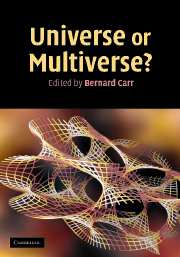Book contents
- Frontmatter
- Contents
- List of contributors
- Preface
- Acknowledgements
- Editorial note
- Part I Overviews
- 1 Introduction and overview
- 2 Living in the multiverse
- 3 Enlightenment, knowledge, ignorance, temptation
- Part II Cosmology and astrophysics
- Part III Particle physics and quantum theory
- Part IV More general philosophical issues
- Index
- References
1 - Introduction and overview
Published online by Cambridge University Press: 05 July 2014
- Frontmatter
- Contents
- List of contributors
- Preface
- Acknowledgements
- Editorial note
- Part I Overviews
- 1 Introduction and overview
- 2 Living in the multiverse
- 3 Enlightenment, knowledge, ignorance, temptation
- Part II Cosmology and astrophysics
- Part III Particle physics and quantum theory
- Part IV More general philosophical issues
- Index
- References
Summary
Introducing the multiverse
Nearly thirty years ago I wrote an article in the journal Nature with Martin Rees [1], bringing together all of the known constraints on the physical characteristics of the Universe — including the fine-tunings of the physical constants — which seemed to be necessary for the emergence of life. Such constraints had been dubbed ‘anthropic’ by Brandon Carter [2] — after the Greek word for ‘man’ — although it is now appreciated that this is a misnomer, since there is no reason to associate the fine-tunings with mankind in particular. We considered both the ‘weak’ anthropic principle — which accepts the laws of nature and physical constants as given and claims that the existence of observers then imposes a selection effect on where and when we observe the Universe — and the ‘strong’ anthropic principle — which (in the sense we used the term) suggests that the existence of observers imposes constraints on the physical constants themselves.
Anthropic claims — at least in their strong form — were regarded with a certain amount of disdain by physicists at the time, and in some quarters they still are. Although we took the view that any sort of explanation for the observed fine-tunings was better than none, many regarded anthropic arguments as going beyond legitimate science. The fact that some people of a theological disposition interpreted the claims as evidence for a Creator — attributing teleological significance to the strong anthropic principle — perhaps enhanced that reaction.
- Type
- Chapter
- Information
- Universe or Multiverse? , pp. 3 - 28Publisher: Cambridge University PressPrint publication year: 2007
References
- 1
- Cited by



